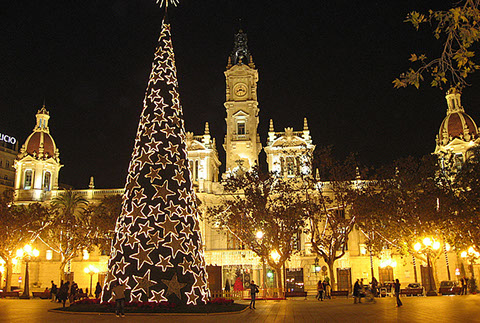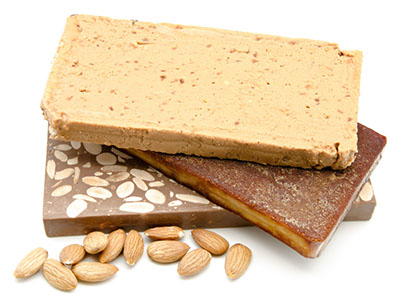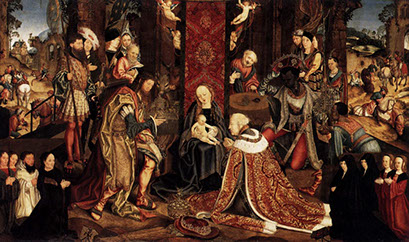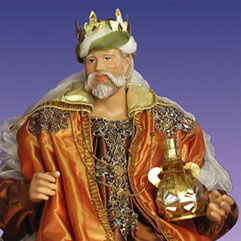Welcome To Christmas Around The World
Learn How Other Children Celebrate Christmas From Different Countries!
Christmas In Spain
Say Merry Christmas in Spain
(Español) - Feliz Navidad or Nochebuena (which means 'Holy Night' - Christmas Eve)
 Christmas is a deeply religious holiday in Spain. The country's patron saint is the Virgin Mary and the Christmas season officially begins December 8, the feast of the Immaculate Conception. It is celebrated each year in front of the great Gothic cathedral in Seville with a ceremony called los Seises or the "dance of six." Oddly, the elaborate ritual dance is now performed by not six but ten elaborately costumed boys. It is a series of precise movements and gestures and is said to be quite moving and beautiful.
Christmas is a deeply religious holiday in Spain. The country's patron saint is the Virgin Mary and the Christmas season officially begins December 8, the feast of the Immaculate Conception. It is celebrated each year in front of the great Gothic cathedral in Seville with a ceremony called los Seises or the "dance of six." Oddly, the elaborate ritual dance is now performed by not six but ten elaborately costumed boys. It is a series of precise movements and gestures and is said to be quite moving and beautiful.
Christmas Eve is known as Nochebuena or "the Good Night." It is a time for family members to gather together to rejoice and feast around the Nativity scenes that are present in nearly every home. A traditional Christmas treat is turron, a kind of almond candy.
December 28 is the feast of the Holy Innocents. Young boys of a town or village light bonfires and one of them acts as the mayor who orders townspeople to perform civic chores such as sweeping the streets. Refusal to comply results in fines which are used to pay for the celebration.
As in many European countries, the children of Spain receive gifts on the feast of the Epiphany. The Magi are particularly revered in Spain. It is believed that they travel through the countryside reenacting their journey to Bethlehem every year at this time. Children leave their shoes on the windowsills and fill them with straw, carrots, and barley or the horses of the Wise Men. Their favorite is Balthazar who rides a donkey and is the one believed to leave the gifts.
 Most families eat their main Christmas meal on Christmas Eve before the service. The traditional Spanish Christmas dinner is 'Pavo Trufado de Navidad' which is Turkey stuffed with truffles (the mushrooms, not the chocolate ones!) In Galicia (a region in north-west Spain, surrounded by water) the most popular meal for Christmas Eve and for Christmas Day is seafood. This can be all kinds of different seafood, from shellfish and mollusks, to lobster and small edible crabs.
Most families eat their main Christmas meal on Christmas Eve before the service. The traditional Spanish Christmas dinner is 'Pavo Trufado de Navidad' which is Turkey stuffed with truffles (the mushrooms, not the chocolate ones!) In Galicia (a region in north-west Spain, surrounded by water) the most popular meal for Christmas Eve and for Christmas Day is seafood. This can be all kinds of different seafood, from shellfish and mollusks, to lobster and small edible crabs.
After the midnight service, people walk through the streets carrying torches, playing guitars and beating on tambourines and drums. One Spanish saying is 'Esta noche es Noche-Buena, Y no Es noche de dormir' which means 'Tonight is the good night and it is not meant for sleeping!'
A few different languages are spoken in different regions in Spain. In Spanish Happy/Merry Christmas is 'Feliz Navidad'; in Catalan it's 'Bon Nadal'; in Galician 'Bo Nadal'; and in Basque (or Euskara in basque) 'Eguberri on'. Happy/Merry Christmas in lots more languages.
December 28th is 'Día de los santos inocentes' or 'Day of the Innocent Saints' and is very like April Fools Day in the UK and USA. People try to trick each other into believing silly stories and jokes. Newspapers and TV stations also run silly stories. If you trick someone, you can call them 'Inocente, inocente' which means 'innocent, innocent'. 28th December is when people all over the world remember the babies that were killed on the orders of King Herod when he was trying to kill the baby Jesus.
New Year's Eve is called 'Nochevieja' or 'The Old Night' in Spain and one special tradition is that you eat 12 grapes with the 12 strokes of the clock at Midnight! Each grape represents a month of the coming year, so if you eat the twelve grapes, you are said to be lucky in the new year.
 Apart from Christmas, there is another festival that is celebrated in Spain that is about the Christmas Story. It is called Epiphany and is celebrated on 6th January. This is the twelfth night after Christmas. In Spanish, Epiphany is called 'Fiesta de Los tres Reyes Mages': in English this means 'The festival of the three Magic Kings'. Epiphany celebrates when the Kings or Wise men brought gifts to the baby Jesus.
Apart from Christmas, there is another festival that is celebrated in Spain that is about the Christmas Story. It is called Epiphany and is celebrated on 6th January. This is the twelfth night after Christmas. In Spanish, Epiphany is called 'Fiesta de Los tres Reyes Mages': in English this means 'The festival of the three Magic Kings'. Epiphany celebrates when the Kings or Wise men brought gifts to the baby Jesus.
Children have some presents on Christmas Day, but most are opened at Epiphany. Some children believe that the Kings bring presents to them at Epiphany. They write letters to the Kings on Boxing Day, December 26th, asking for toys and presents. And on Epiphany Eve (January 5th) they leave shoes on windowsills or balconies or under the Christmas Tree to be filled with presents. Gifts are often left by children for the Kings, a glass of Cognac for each King, a satsuma and some walnuts. Sometimes a bucket of water is left for the camels that bring the Kings! If the children have been bad, the Kings might leave pieces of coal made out of sugar in the presents!
Some big towns and cities have Epiphany Parades with each King having a big float that is shaped like a camel. Sometimes there are also real camels in the parade. The Three Kings in the Spanish Epiphany are:
Gaspar, who has brown hair and a brown beard (or no beard!) and wears a green cloak and a gold crown with green jewels on it. He is the King of Sheba. Gaspar represents the Frankincense brought to Jesus. Frankincense is sometimes used in worship in Churches and showed that people worship Jesus.
 Melchior, who has long white hair and a white beard and wears a gold cloak. He is the King of Arabia. Melchior represents the Gold brought to Jesus. Gold is associated with Kings and Christians believe that Jesus is the King of Kings.
Melchior, who has long white hair and a white beard and wears a gold cloak. He is the King of Arabia. Melchior represents the Gold brought to Jesus. Gold is associated with Kings and Christians believe that Jesus is the King of Kings.
Balthazar, who has black skin and a black beard (or no beard!) and wears a purple cloak. He is the King of Tarse and Egypt. Balthazar represents the gift of Myrrh that was brought to Jesus. Myrrh is a perfume that is put on dead bodies to make them smell nice and showed that Jesus would suffer and die.
Christmas in the Basque Country
In the Basque country (which is a part of northern Spain and southern France), on Christmas Eve, children's presents are delivered by a magical man called Olentzero. He's a big, overweight man wearing a beret and smoking a pipe. He dresses like a Basque farmer.
Christmas in Catalonia
In the Catalonia province of Spain there's a Christmas character called 'Tió de Nadal' (the Christmas log) or he's sometimes known as 'Caga tio' (the pooping log!). It's a small hollow log propped up on two legs with a smiling face painted on one end. From the 8th December (the Feast of the Immaculate Conception) Catalan families gives the log a few morsels of food to 'eat' and a blanket to keep it warm. On Christmas Day or Christmas Eve, the log then 'gives out' small gifts! People sing songs and hit the log with sticks to help its 'digestion' and the log drops sweets, nuts, and dried fruits. When garlic or an onion falls out of the log, all of the treats are finished for the year.



Copyright © 1996 THE-NORTH-POLE.COM Designed by LeNewit.com
HOME | ABOUT | PRIVACY POLICY | TERMS OF USE | CONTACT US

